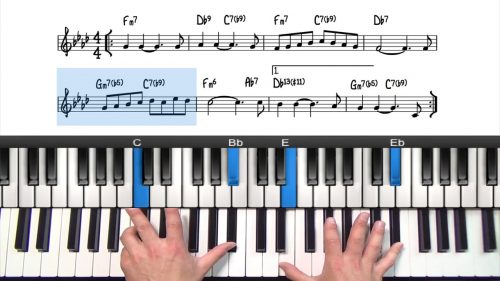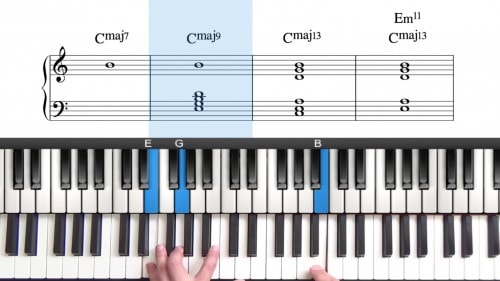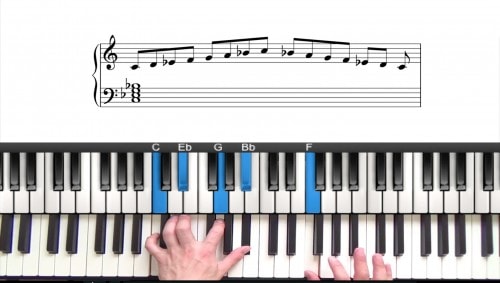Altered Jazz Chords Tutorial
We know that in a minor 251 progression, the 5 chord in the progression will usually be an altered dominant chord. In this lesson we are going to apply altered dominant chords to the major 251 progression.
Adding alterations is done by either raising of flattening the upper extension of the 5 chord in a 251 progression. This is most common on the 5 chord which adds extra tension and dissonance and then strengthens the sense of resolution to the 1 chord.
How to practice altered jazz voicings?
Well one way to practise these progressions would be to run through them through all 12 keys, starting off with a so what voicing for the 2 chord and then playing an upper structure of your choice for the 5 chord.
The second way would be to run through all of the standards you can play and simply look out for major 251’s where you can apply these voicings. Something to keep in mind here is the melody over the 5 chord.
If you can identify the upper structure that contains the melody note you can harmonise the melody with the upper structure. Something to be aware of is that it is difficult to do this on the fly or harmonise the melody like this whilst improvising. Instead you should examine the melody notes in your practise time and work out what upper structure triads work.
Combining so what chords and upper structure triads
We can play a SW voicing for the 2 chord with an upper-structure for the 5 chord. So let’s start of with a G So What chord which is a G minor 11. To get to C7#5#9 we play the tritone in the bass (E and Bb) and an Ab major triad in the right hand. The 2nd inversion of the Ab triad works best from a voice leading perspective. We can then resolve to any Fmaj voicing.
We could take this further still and combine multiple upper structures on the 5 chord. Using the same 251 in F major. We start off with the G so what chord, then move to the C7#5#9 and then keep the tritone in our left hand but play a Gb major triad after the Ab major triad.
This gives us C7 b9 #11. To get b9 #11 tensions, we build a major triad off the #11. We would then resolve this in the same way to an F major voicing.
Lesson Downloads
-
3 Note Major 251 Progressions File Type: pdf
-
Rootless Major 251 Progressions – 12 Keys File Type: pdf
-
Jazz Voicings Cheat Sheet File Type: pdf
Practice Tips
-
The key is to memorise these voicings is to remember the formulas in terms of scale degrees.
-
If you like the sound of one of the voicings... for example - a G7b9 chord. Open your fake book, or flick through the jazz standards you have learnt and look out for a G7 chord.
-
When you find one, try your voicing, you will likely have to work out the notes using the scale degree formula. Perhaps starting with the root at the bottom and working up.
- By doing this you will retain the shape and the information much better… because you have taken the time to work it out.






The voicing you do on the first grade before the upper structure at 9.24 is huge…it is really necessáry to play it with the root and the 11?I have become confortable using rootless voicings after a lot of training …so when i see this huge a@@ Both hand voicing its like learning a new voicing all together.
no sound on lessons not a one…midi files loud and clear
I’m trying to do this on my cell phone but it doesn’t seem to work properly am I correct ?
I am 88 and have always wanted to play cool jazz piano but with limited time left I am practicing your jazz standards eg (reminds me of you ) and honestly I am blown away by my progress Hoagy Charmicheal sang a song in the 40s called the old music master who he said hit a chord and knocked it into the infinite and when I play some of the chords you have written that’s what happens to me I seem to go into resonant frequency Thanks
Hey Eric – that’s great to hear on your progress.
Yes the jazz standards are very fun to play. For Hoagy Carmichael, I love his following tunes:
Georgia On My Mind: Part 1 – https://www.pianogroove.com/blues-piano-lessons/georgia-on-my-mind-tutorial/ Part 2 – https://www.pianogroove.com/blues-piano-lessons/georgia-on-my-mind-tutorial/
Stardust: Part 1 – https://www.pianogroove.com/jazz-piano-lessons/stardust-tutorial/ Part 2 – https://www.pianogroove.com/jazz-piano-lessons/stardust-intro-tutorial/
I think you will enjoy those lessons 🙂
Cheers, Hayden
can we use alterations om any dominant 7 th chord or only those in a 2-5-1 progression ?
Hey Terry 👋
Great question!
Yes alterations can be applied to any dominant chord. The 251 progression is the most common progression in jazz music and so most often dominant chords are found as part of this progression.
However, it’s also common to have ‘incomplete 25’ progressions where we just have the 2 and 5 chords and then the harmony moves elsewhere. We can apply alterations to the dominant chords in this situation.
It’s also common to find longer progressions such as 36251 progressions. Check out our cocktail piano improvisation course here where we focus on the tune “Misty” and in the first lesson we explore the 3625 progression: https://www.pianogroove.com/jazz-piano-lessons/cocktail-improvisation-for-beginners/
You will notice in the first lesson of the Cocktail Improv course, that I show how to voice all of the chords in the 3625 progression as dominant chords, and indeed we can add alterations to all 4 chords if they are voiced as dominant chords.
In the Cocktail Improv course there are many studies and applications of alterations and how they can be applied in our harmonies and in our improvisations, and so work through these lessons and I think they will be a great fit for you.
A final point is that you should not feel that you have to play alterations on every dominant chord. Yes it’s an option, but sometimes just playing the basic 7th chord, or using the unaltered 9th and/or 13th can be very beautiful too. Ultimately, understanding alterations just gives us more options for our chord voicings.
I like to use the analogy of cooking, and the alterations are the ‘spices’ and ‘herbs’ that we can add into our dishes to create more complex tastes and flavours. Of course, we need to add spices and herbs with moderation otherwise the taste can be overpowering.
Think of adding alterations in the same way, they are nice to add to create a more complex and sophisticated sound, but that doesn’t mean that we need to add them all of the time.
Above anything else, follow your ears and experiment with different voicings and alterations and you will learn a lot in the discovery process. There are only 4 possible alterations for a dominant chord (b9, #9, #11, and #5/b13) and so when you encounter a dominant chord you can try and test these different options. It’s unlikely that all of them will sound good for a specific chord in a specific setting, which is why it’s good to test them and gradually you will build an appreciation for what alterations work well in specific harmonic scenarios.
Please let me know if you have any further questions and enjoy the lessons!
Talk soon,
Hayden